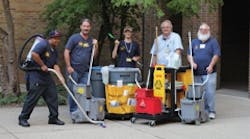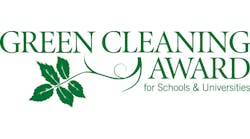GCA Higher Education Honorable Mention
University of Michigan, Ann Arbor
PROGRAM INFORMATION
Number of students: 42,000
Square footage maintained: 14 million
Number of full-time custodians: 365
Annual cleaning budget: $22 million
Green cleaning team members: John Lawter, Associate Director, Plant Building & Grounds Services (PBGS); Colette Donner, Area Manager, PBGS; Carie Kloack, Area Manager, PBGS, Head Custodians; Jim Ginnaty, Training Manager, PBGS; Bill McAllister, Garage Senior Supervisor, PBGS; Kristin Brancheau, Business Manager, PBGS; Henry Musial, Area Manager, PBGS
The University of Michigan’s Plant Building & Grounds Services (PBGS) department began green cleaning in May 2009 with the introduction of the OS1 (Operating System One) cleaning program to campus. Although the impetus for this change from traditional one-cleaning system was to increase building cleanliness in light of declining budgets, the university has embraced the OS1 philosophy of “Clean first for health, then for appearance.”
Thus far, the program has resulted in the reduction in chemical use and storage on campus from more than 50 products to less than 10. Additionally, 311 full-time employees and 51 temporary employees have been retrained in the OS1 system of cleaning for health, disposing of wastes in an environmentally friendly manner, employing ergonomic practices, improving building sanitation, removing pollutants and reducing chemical, particle and moisture residue.
It is in its final year of a five-year rollout of the program to campus. The green cleaning system now is in 139 of the 236 campus general-fund buildings, equating to 82 percent of building area, with a completion date for rollout in May 2013. PBGS also investigates other innovative green cleaning processes.
Since being recognized with an Honorable Mention for the 2011 Green Cleaning Awards for Colleges and Universities, a new floorcare program has been instituted, which has eliminated the use of chemicals for natural stone, terrazzo and concrete flooring.
At the core of the (OS1) system is cleaning for health first, then for appearance. Various methods are used in (OS1) to help ensure the prevention of airborne particulate matter and the spread of viruses and bacteria within a facility. Backpack vacuums used in this system are CRI-certified under the Green Label program and meet stringent criteria associated with soil removal ability and dust containment. Flat mops are used alongside two-chamber buckets that minimize cross contamination between clean and soiled water, removing 96 percent of surface debris and bacteria. Both the mops and buckets are ergonomically designed to help prevent employee injury. Custodians also are provided with tools that enable debris to be picked up in restrooms without custodial staff coming in direct contact.
Disinfectants are only used within restrooms. Custodians and campus community members are encouraged to wash their hands verbally and through a campus outreach plan from the University’s Occupational Safety & Environmental Health department.
The use of mats at public entryways is standard practice in the (OS1) program. Mats are placed at all public campus entryways and are at least 10 feet long. Mats are vacuumed regularly and are deep-cleaned on a scheduled basis. Entryways are maintained through a daily cleaning routine that includes vacuuming, dusting and mopping.
Low-maintenance vegetation is installed at public building entrances, and plants are selected based on an integrated pest management approach to eliminate pesticide applications that could be tracked into the building. Exterior walkways are maintained by blowing or sweeping pavement to completely remove dirt or other debris from pedestrian paving surfaces. Dirt and debris also are removed from the flat surfaces of paving, corners between paving and walls, the tops of walls, if visible, from under site furniture, from stair treads and risers and from handicapped ramps.
U-M offers a variety of recycling programs on campus. The single-stream recycling program enables cardboard, paper, glass, most plastics and metal to be placed in a single recycling bin. Additionally, there are programs to reuse or recycle large scrap metal, scrap wood, electronics, hazardous chemicals, polystyrene, packing peanuts, writing instruments and office supplies.
(OS1) employs in-depth training based on standardized tools and procedures. Supervisors and custodians are trained on all aspects of the program. Initial training consists of a 16-hour boot camp that emphasizes the (OS1) philosophy of cleaning:
-Cleaning for health first then appearance.
-Treating custodians as first class citizens.
-Simplification and economy in the cleaning process.
-The “clean syndrome,” a generalized description of the systematic cleaning process.
-Beyond compliance policy for safety regulations.
-Minimization of environmental impact.
-High-performance culture of exceeding all expectations.
All training includes instruction on safe work habits, including proper lifting, proper waste handling and removal, wearing personal protective equipment (PPE), mixing chemicals and washing hands regularly.
Everyone who works with or is potentially exposed to chemicals receives information and training on the chemicals in their work area at the time of their initial assignment and whenever a new physical or health hazard is introduced to their work area. Training includes classroom instruction, handouts, discussion and hands-on demonstrations. Additionally, custodians participate in Beyond Compliance and Protect Yourself trainings, and U-M Occupational Safety and Environmental Health (OSEH) conducts yearly compliance trainings for all employees.
The performance of the (OS1) system is measured through the use of building auditors from U-M Plant Operations Work Management department who inspect areas cleaned by PBGS staff using the APPA “Custodial Staffing Guidelines.” Using staff from another department helps ensure an unbiased assessment of the aesthetics of areas cleaned using (OS1). On average, buildings participating in (OS1) achieve a 1.87 score on the APPA scale after 9 months in the program. Additionally, during the 2011-2012 academic year, a 10 percent improvement in APPA cleanliness scores was recorded in OS1 areas vs. the traditional zone cleaning areas.
ManageMen, the company that owns the (OS1) brand, also conducts annual audits on campus to ensure compliance with the green cleaning program. During this year’s audit, the 4 selected buildings scored from 83% to 87%, with 80% compliance as the goal.
From the onset of the decision to deploy (OS1) to the University of Michigan campus through today, stakeholder engagement has been at the top of the priority list. This is not only toensure support for the change in how buildings are cleaned, but also to educate campus users on the environmental and human health impacts of this new system. A poster campaign was launched in 2010 to educate campus about all aspects of this new cleaning system. When a new location is added to (OS1), an open house is held in that building that features information about the program, the concept of “cleaning for health first” and green cleaning in general.
In order to further broaden its outreach efforts, PBGS is commissioning a series of videos on the cleaning industry and green cleaning. The feel of these videos will be light-hearted and fun; paired with distribution through social media, e-mail and website presence. The hope is that they will be viewed by a wider audience than traditional outreach materials like pamphlets.
To date, presentations have been made to several campus groups, including the Executive Leadership Group, comprised of the university’s president and vice presidents; the Executive Planning Group, comprised of deans and directors from individual colleges, schools and institutes; the budget Administrators Group, comprised of the business managers for the colleges and schools; the Custodial Services Process Improvement Team, comprised of staff members concerned about campus custodial issues; and the Facility Users Network, comprised of facility managers from colleges, schools, institutes and departments on campus.
Additionally, presentations have been made to audiences from outside the University of Michigan, allowing PBGS to reach a broader audience and spread the word about the importance of cleaning for human and environmental health. Members of the department have presented on (OS1) at the Big 10 & Friends and MiAPPA (Michigan Association of Physical Plant Administrators) conferences. Attendees included those from peer institutions who are responsible for custodial services as well as their colleagues who may be able to encourage them to further investigate green cleaning. Additionally, it has presented, from 2009 through 2012, on its experience with the program at the annual (OS1) Symposium, a national conference on best practices for (OS1) users.
PBGS’ use of the (OS1) program helped contribute to the University of Michigan Law School’s achievement of LEED Silver certification for its new South Hall.
In 2011, U-M PBGS was recognized with an Honorable Mention from the Green Cleaning Awards for Schools and Universities. Additionally, since beginning the (OS1) program, the department has achieved and maintained CIMS (Cleaning Industry Management Standard) certification and has also been awarded the CIMS Green Building Certification.

